‘RECOVERING MY CITY BY REFLECTING ON THE CONCEPT OF CHANGE’ Titiro whakamuri Kokiri whakamua. Look back and reflect So you can move forward.
‘CHANGE’ Recovering Change Within My City, and Recovering Historical Knowledge Through Research. (My Final Presentation of Photographic work: ‘RECOVERING’ after ‘Discovering and Uncovering’ Studio Wall, 06.05.21. )
Left Wall Hanging Panels: CHANGING Aotearoa during the 19th/20th Centuries = Society, People, Values, Culture, Art – Sculptural Monuments and Statues in Auckland. / 21st Century Map of Tāmaki Makaurau Māori Tribal areas.
Right Wall Hanging Panels: CHANGING City Construction and Architecture – OLD BUILDINGS, (19th century Victorian Era, and 20th centuries) versus NEW BUILDINGS, (20th, 21st Centuries).
Central Wall Hanging: CHANGING Me (Reflections) in Auckland, and CHANGING negatives via Pinhole Camera Photography.
Far Left: CHANGE research about monument figures, and an Auckland Map.
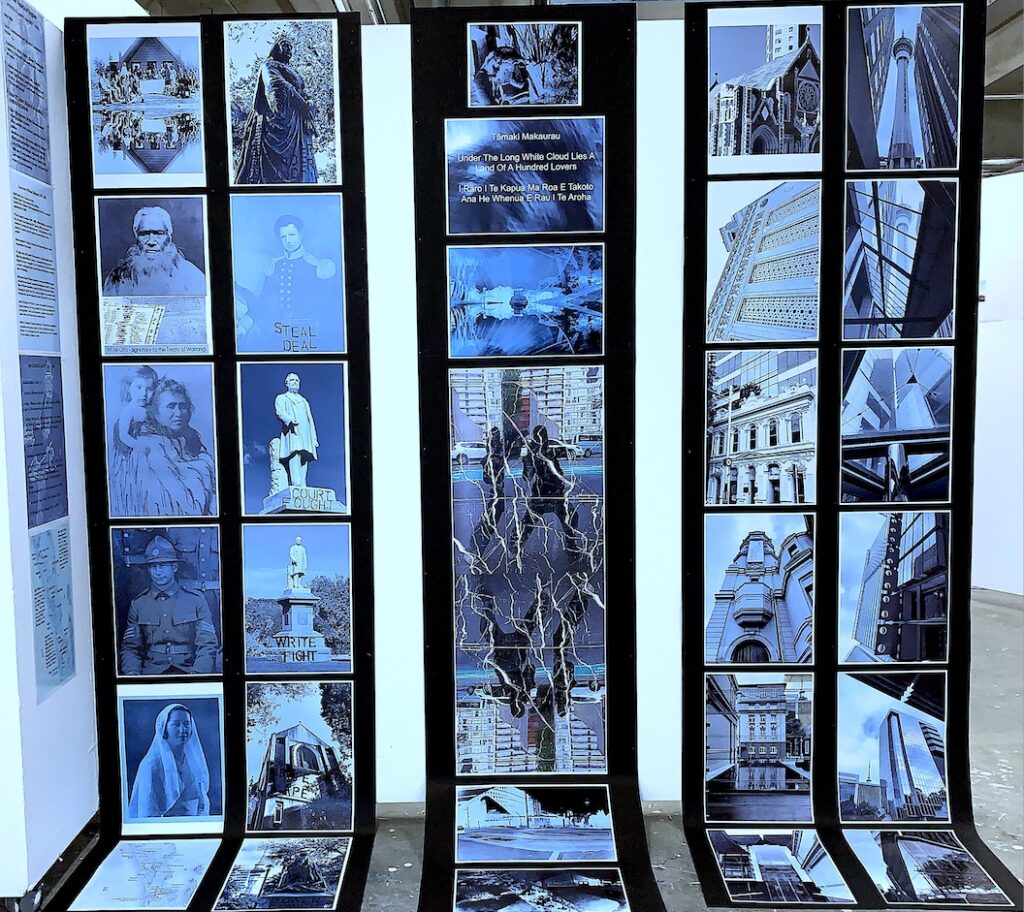
My Final Presentation of Photographic work in the Studio Wall, 06.05.21.
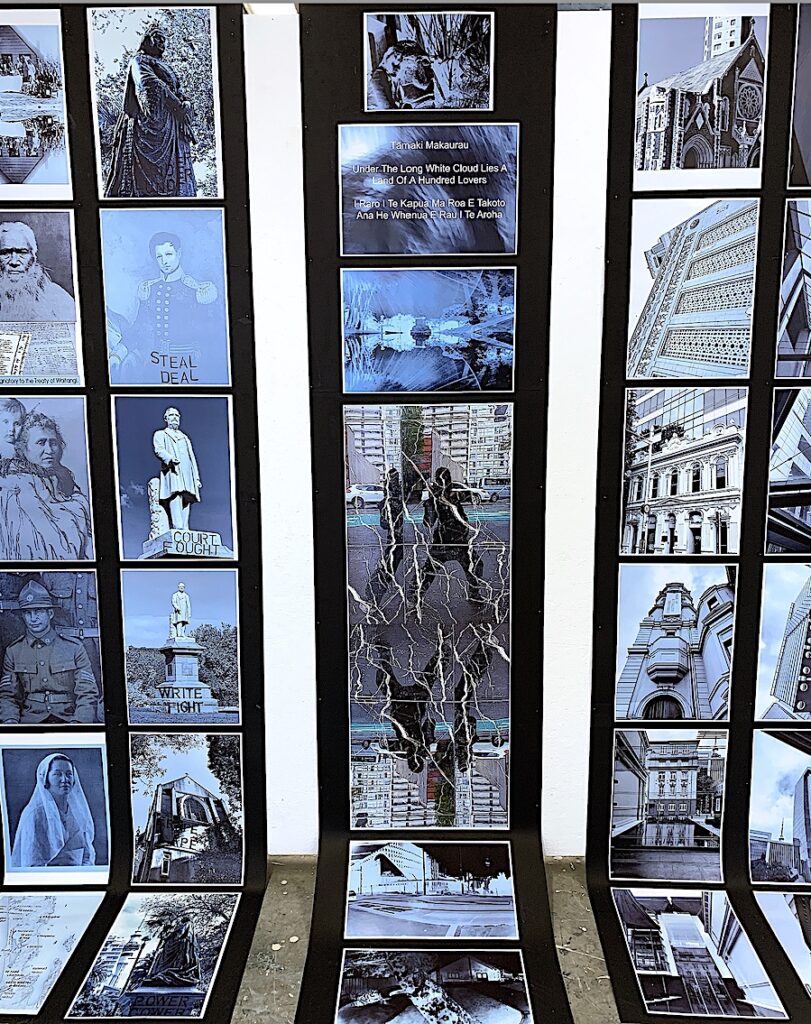
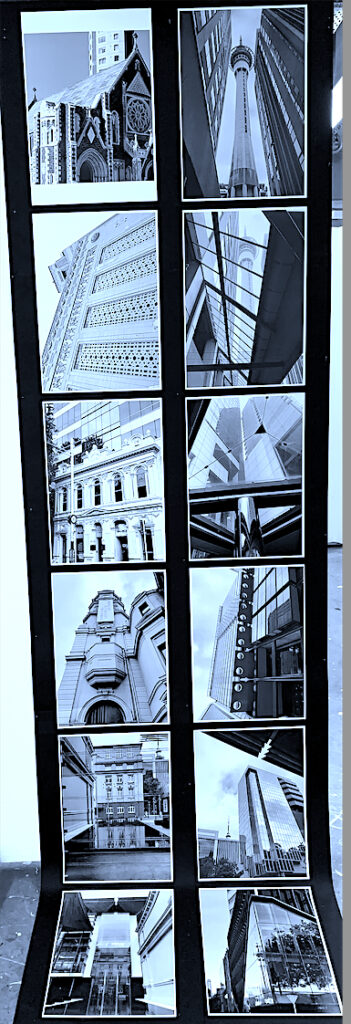
Right Wall Hanging: As I walked alone on my ‘Uncovering’ journey of the brief, I felt free, liberated and so happy to pound the pavements of the CBD. Not only was I uncovering my confidence and belief in myself as an artist, and documentary photographer, I was also uncovering a multitude of visual imagery that surrounded me, both high and low to see.
There was an enormous amount of rowdy, raucous CLUTTER, and CONSTRUCTIONAL CHANGE occurring on pavements, roads, underground networks and high rise building sites in Auckland city. I found the traffic, noise and pollution quite overwhelming, and far greater than in the early 1990s, when I attended The University of Auckland. I noticed many CHANGES that have since occurred.
I was attracted to, thus made connections to, both the OLD architectural style buildings (from the 19th century Victorian Era, and 20th century) and the NEW architectural style buildings (from the late 20th and early 21st centuries). The last photograph (above, on the bottom left) shows my CHANGE & CONNECTION thematic focus with the OLD & NEW CONSTRUCTIONS. I photographed this part of the Auckland Art Gallery’s extension because it was an architectural collaboration of OLD and NEW. The front attachment of the new Art Gallery building connects by merging into the original old Art Gallery’s frontal facade in a beautiful, and seamless way.
On the left, (second photograph from the top) is a photograph I took of the outside of the Civic Theatre on Queen Street. I wished to photograph the inner beauty of this theatre, in particular the art deco elements, staircase and decorative ceiling. Originally, I wanted to focus on this theatre and its history as a theme to study, and photograph. Yet, I was unable to enter, because it was not open to the public.
Making a trip to observe the two demolished Queen Street theatre places, (spaces that I have performed in) evoked very happy memories of living the theatre life, and performing on the stage. I wandered down memory lane, recovering significant Auckland momento images from my past, such as the theatre’s stage, decorations, front of house, backstage, dressing rooms, and the story of the ghost that haunted His Majesty’s Theatre.
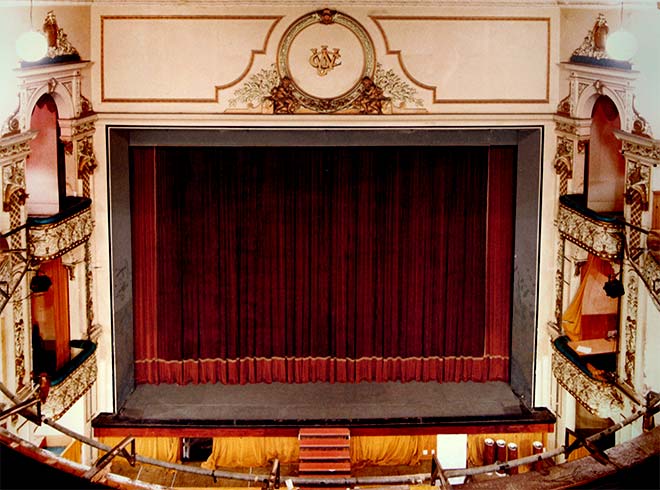
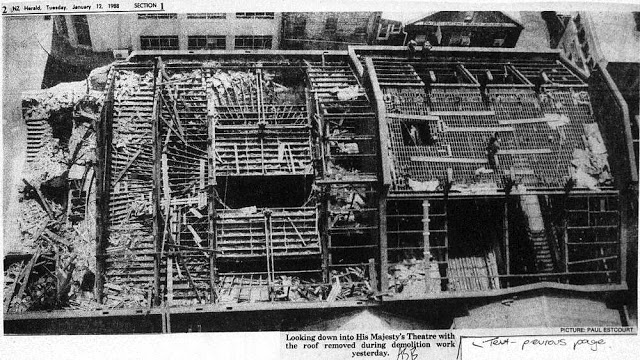
CHANGE: This building above was DECONSTRUCTED, and then replaced. The other theatre, the St. James (see below) was also sadly demolished, and it has remained an empty, boarded up demolition site for years.
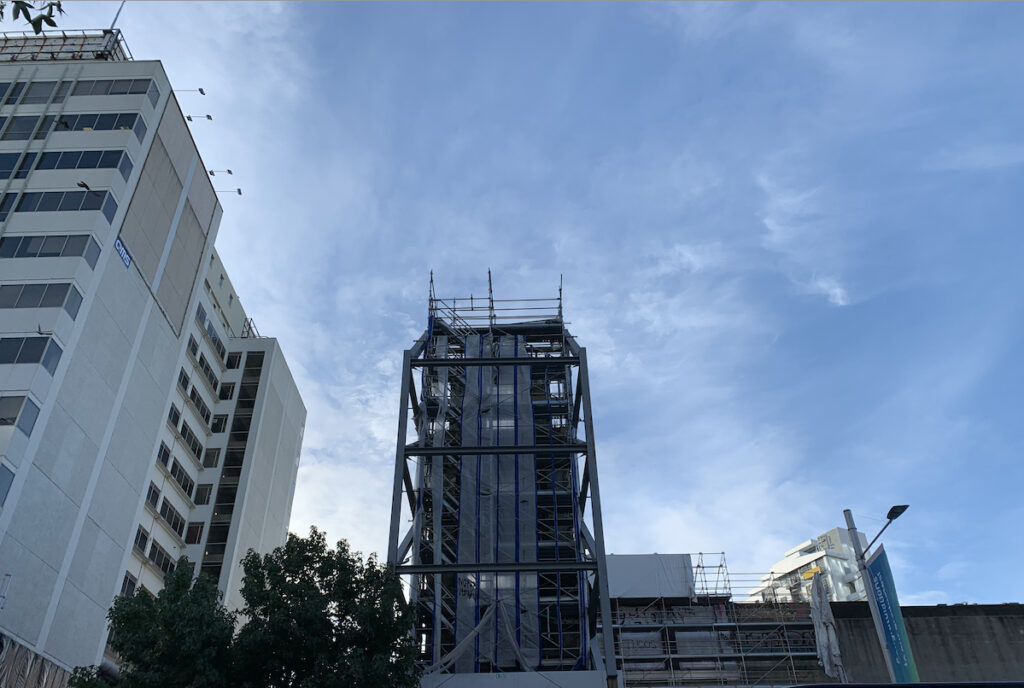
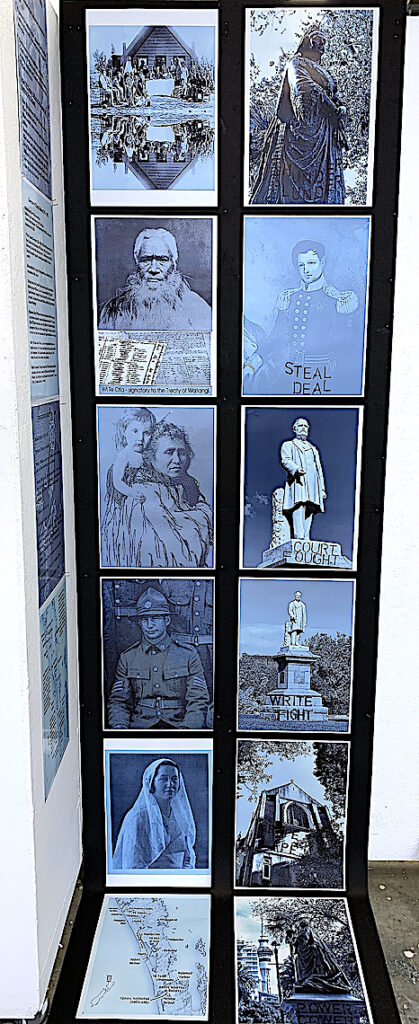
Left Wall Hanging: Above, I created a timeline displaying vertical historical parallels between eras, and people (Māori and Pakeha). Across in a horizontal format I have matched photographs, to create connections between the history, (and stories) of my whakapapa with the Auckland Victorian monuments, and Ngāti Whātua (the tangata whenua of Tāmaki Makaurau).
As part of my recovery process, some photographs received a layer of handwritten text (rhyming words), to outwardly express my feelings concerning the impact of colonisation on Aotearoa’s indigenous population, such as:
Power, Cower: (Bow and cower to the power of the colonial British Empire.)
Plunder, Thunder: (Military might: The New Zealand Wars – Taranaki and Waikato, 1845 – 1872. / Musket gun and cannon noise.)
Steal, Deal: (Land stolen, and confiscated. The New Zealand Company started in 1825, then merged in 1837, and up until 1858 it resold land that it didn’t own. / Treaty (deal) of Waitangi – Māori Chiefs signed a Māori version in good faith.)
Court, Fought: (The Native Land Court / Fighting occurred between British Soldiers, Settlers, and Māori such as the New Zealand Wars. / Intertribal conflict.)
Write, Fight: (Scholar Sir Governor Grey paid respect to Māori by writing about their traditional myth beliefs. / There were many 19th century skirmishes and disputes over land, which escalated into battles with military intervention. Peaceful protesters at Parihaka (1870s – 1880s) were attacked and treated poorly.)
Rape, Ape: (Rape is about power over another – Rape of the land, Rape of people. / Missionary power, Clergy and Church power, Church gaining power through land ownership. Thus, I am questioning who is the APE here?)
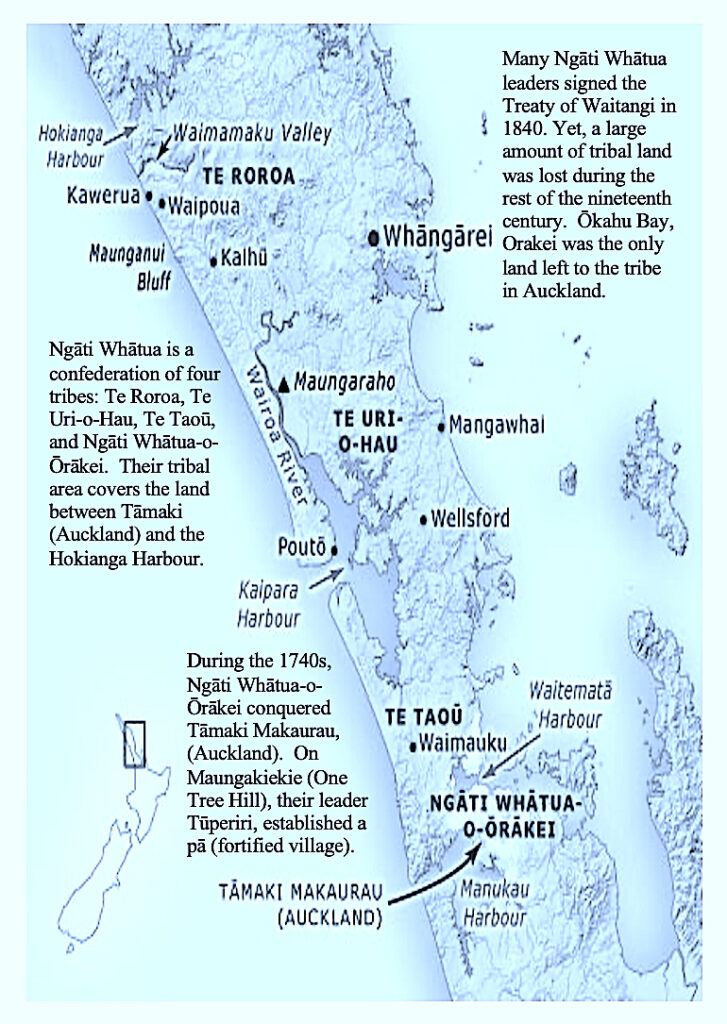
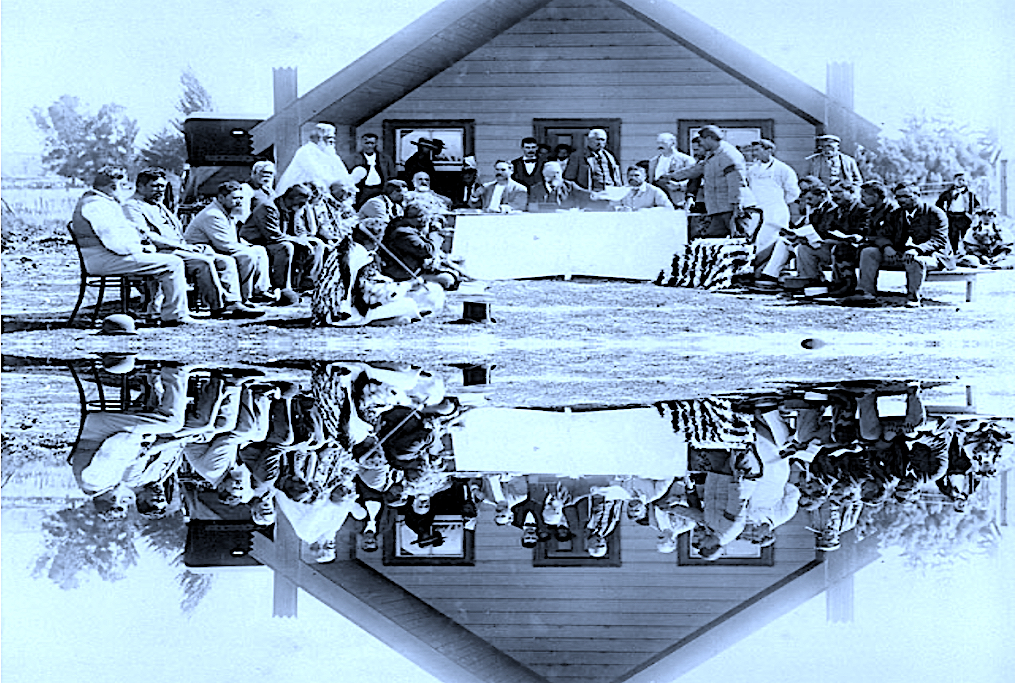
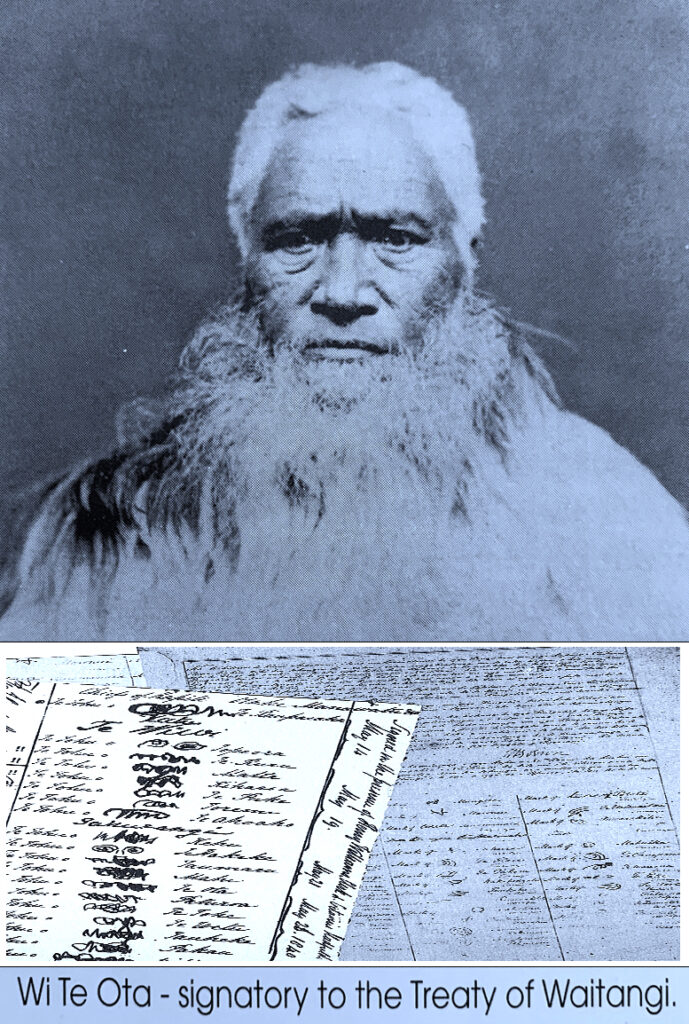
He Whakamaharatanga Wiremu Te Ota, a chief of the Ngāti Te Upokoiri and Ngāti Hinemanu sub-tribes lived at Omahu until the turbulent times of the 1820’s when the people of Heretaunga went into exile.
Wi Te Ota followed the Ngāti Te Upokoiri to Manawatu where they were to reside until the repatriation of the 1850s. It was there he and his brother signed the Treaty of Waitangi.
He died in 1884 and is buried beside his wife, Ruta Te Wharehaehae, on Te Rae o Tahumata.
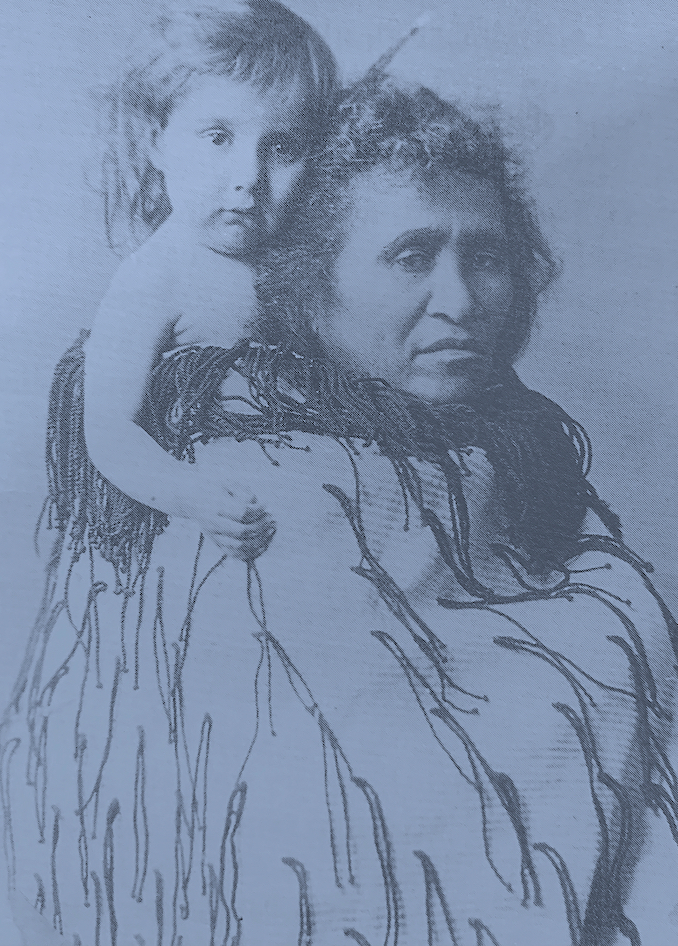
Keita Ruta, as a chief’s daughter owned land. The increase of settlers in the 19th century, meant a demand for land. Her land was taken, when an 1892 Privy Council decision divided her hapu and ancestral Omahu land into four blocks. She became a grantee of a Crown Grant. Unfortunately, the majority of the Māori grantees’ shares of land were squeezed into one part: Omahu Block 2, and they were awarded equal shares of this land. But with no money, they could not survey the land, nor fence it off for farming. Omahu Block 2 (her hapu land) was again partitioned again in 1897.
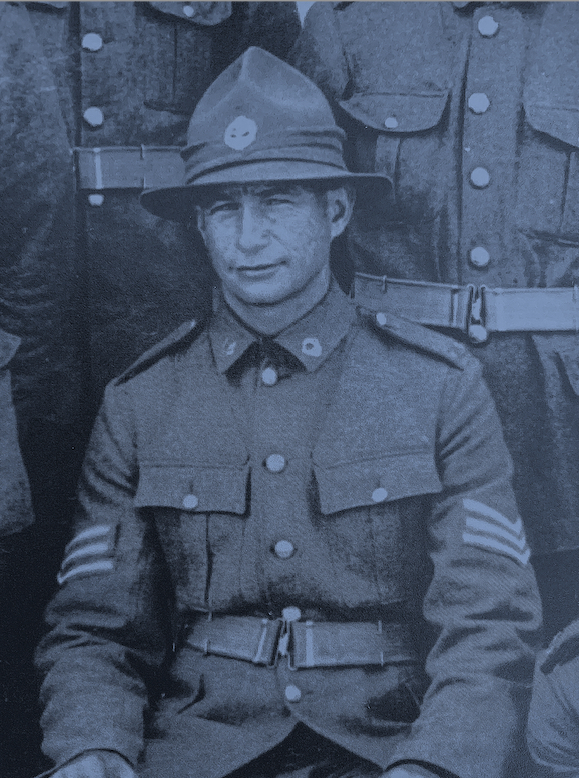
‘FIGHT FOR KING AND COUNTRY’ was a popular slogan in the early 20th century. Māori had different views about fighting for a British Crown in WW1, after many 19th century impacts of disease, war and land confiscation, etc., caused damage.
Some Māori leaders believed signing up to war would strengthen Māori claims for equal status with Pākehā. As a WW1 Sergeant in The Māori Pioneer Battalion: 4th Māori Contingent (2nd Platoon), my Great Grandfather: John Junior Holden’s platoon boarded the ships HMNZT56 Maunganui and HMNZT57 Tahiti on the 26th June, 1916. He was lucky to survive the 1st World War and return to Aotearoa.
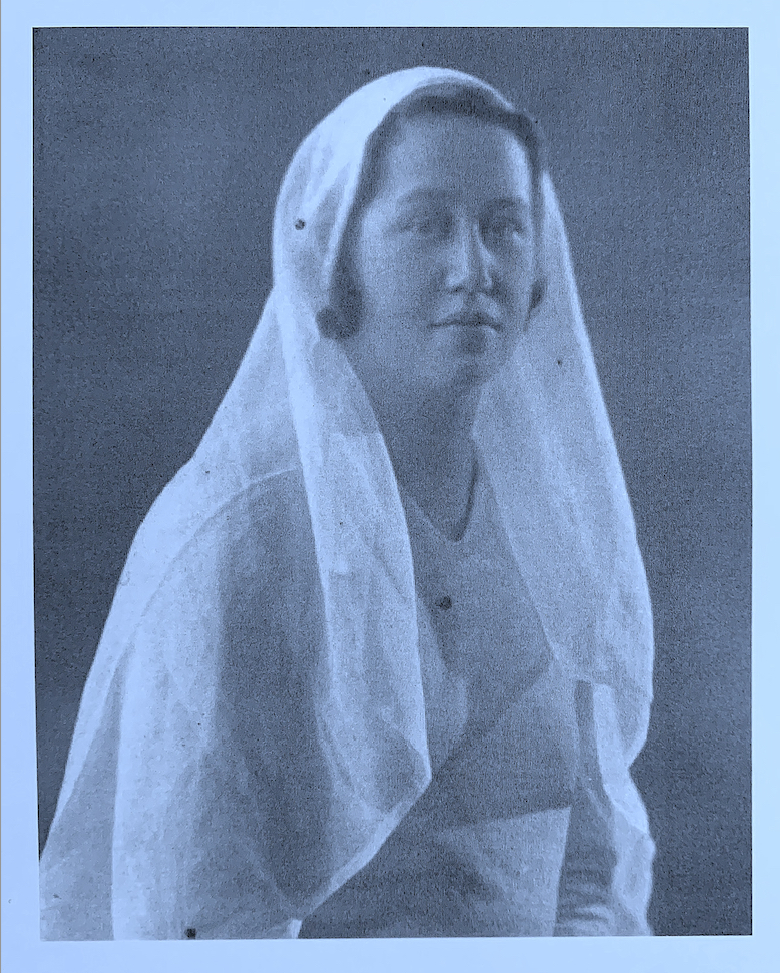
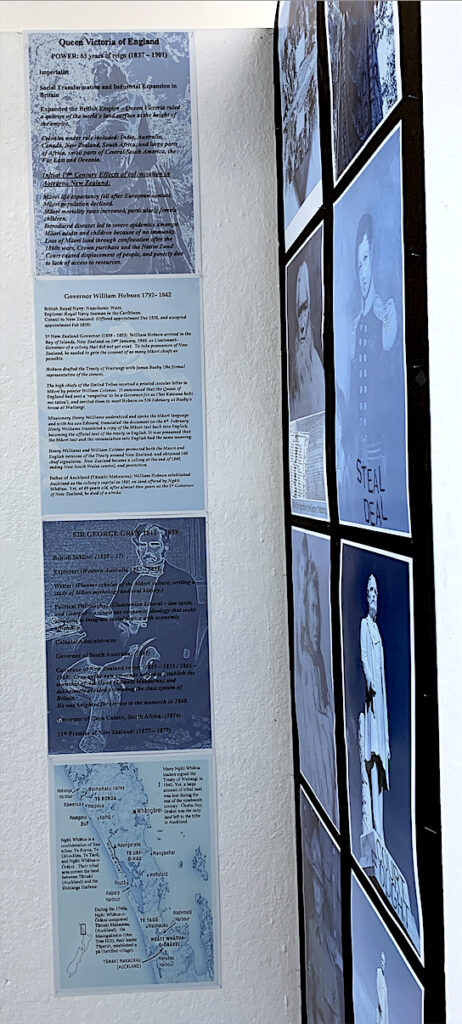
Researching monuments at Albert Park, Auckland City. I recovered historical information by reading, gathering information, writing and photographing the statues of Queen Victoria and Sir Governor Grey.
Queen Victoria: To present my research for Queen Victoria, I recreated one of my original close-up photographs (see below), by using a digital drawing technique on top of the photograph, then layered my text on top.
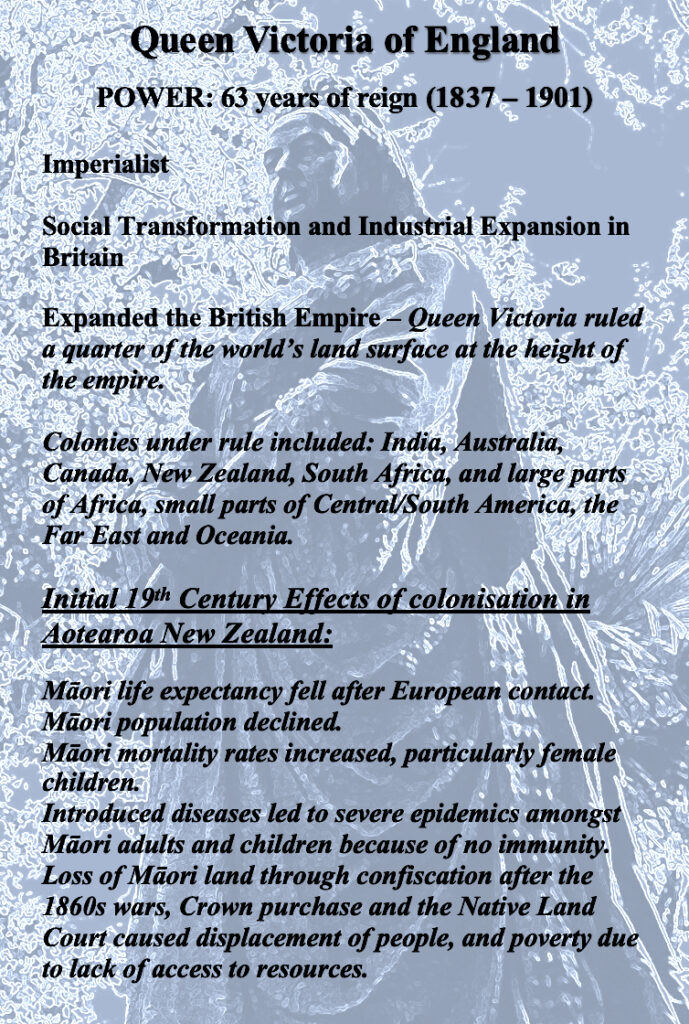
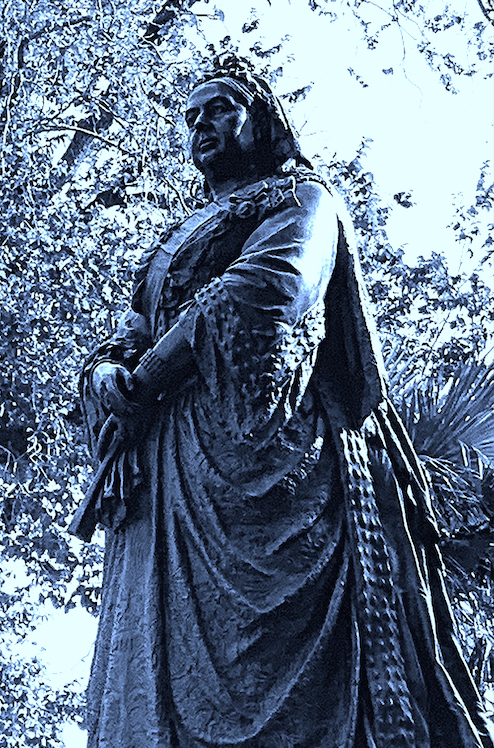
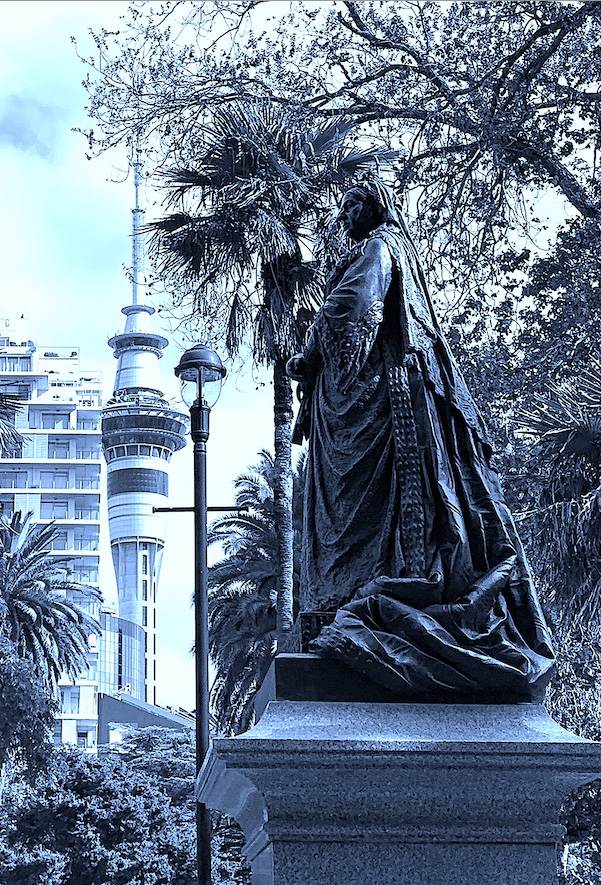
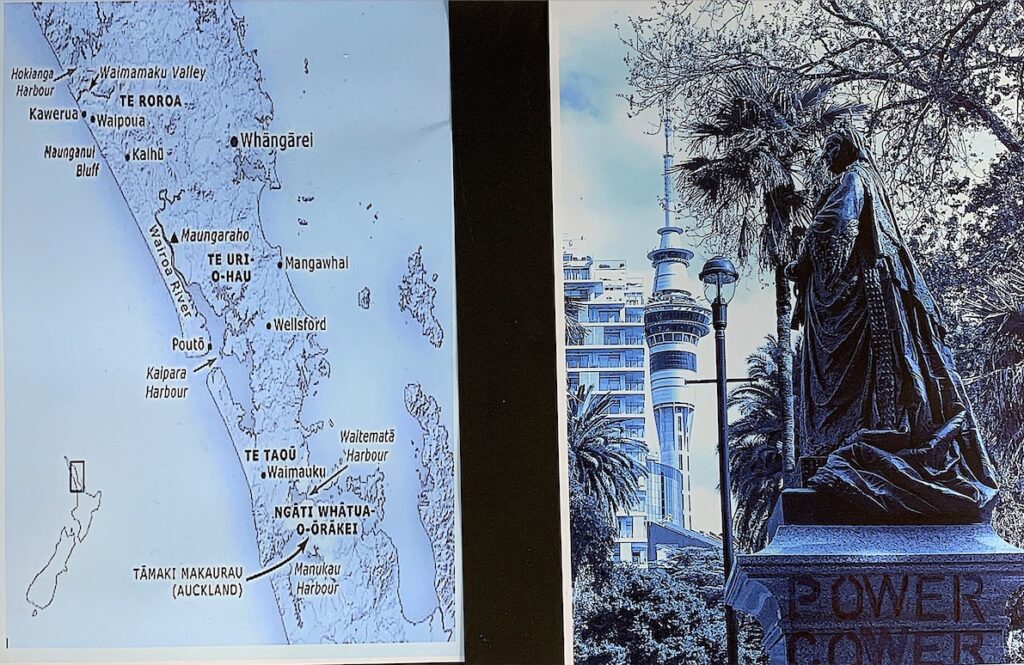
19th, 20th COLONISATION CHANGE & 21st COLONY CHANGE: On the right, I added a handwritten rhyming text such as ‘POWER, COWER’ to Queen Victoria’s Monument plinth. She stares above, and out across her domain, her POWER, and military might would have made the indigenous populations of her colonies COWER. Yet, her Aotearoa dominion has changed over time, and grown up, above and around her, perhaps New Zealand will become independent, and a republic. Therefore in opposition, I placed her photograph horizontally opposite a map representing Aotearoa’s indigenous population, and the mana whenua (the right of a Maori tribe to manage a particular area of land) of Tāmaki Makaurau, and the surrounding area north.
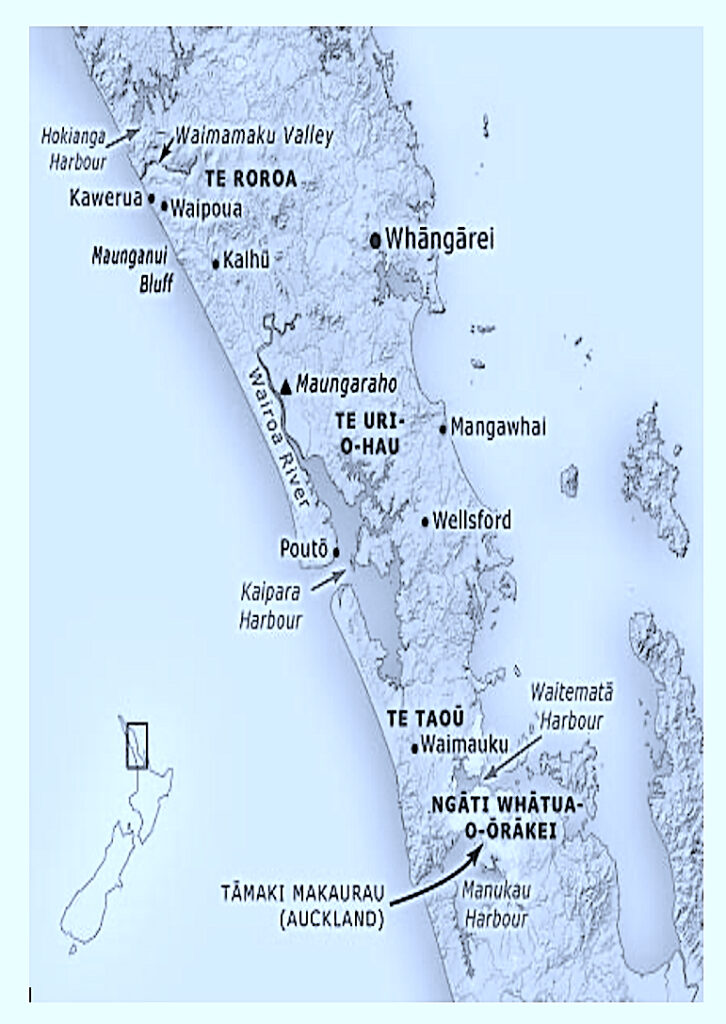
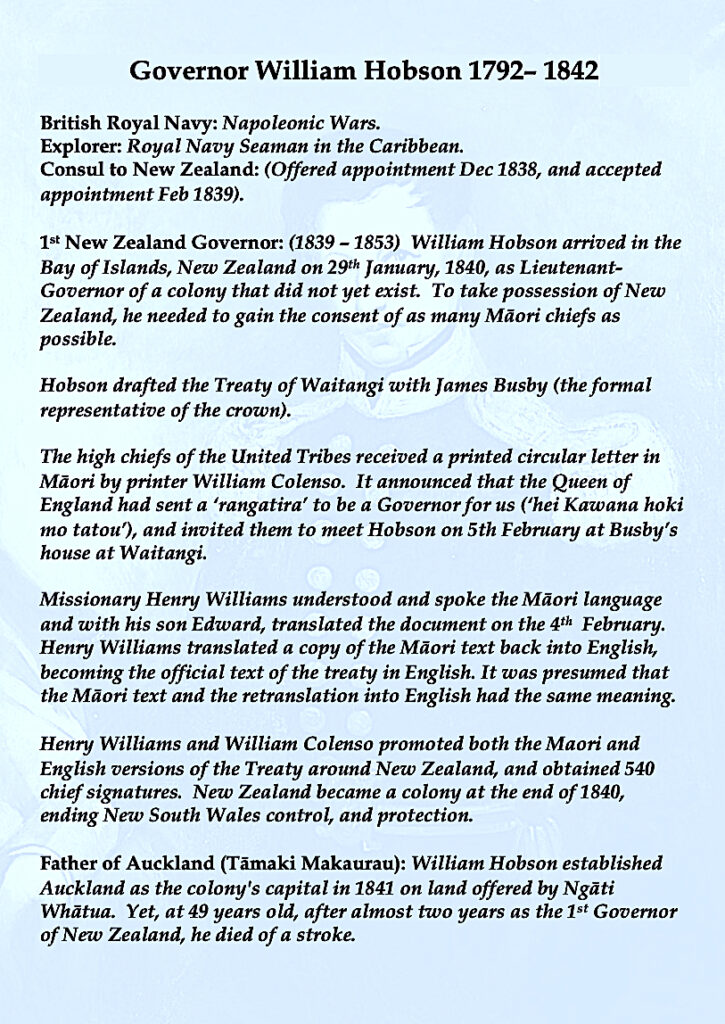
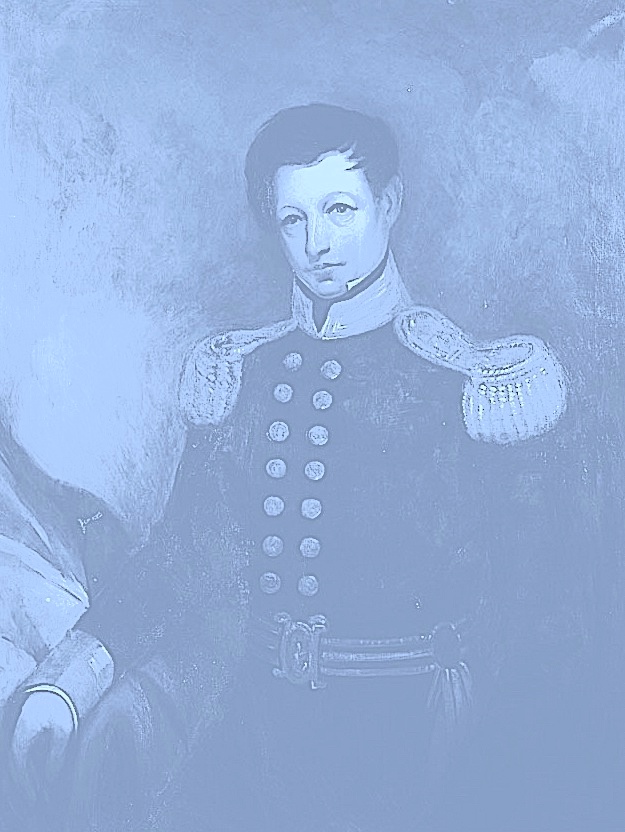
Sir George Grey: To present my research, I recovered a photograph of George Grey and manipulated the image by overlayering my digital drawing and my writing on top.
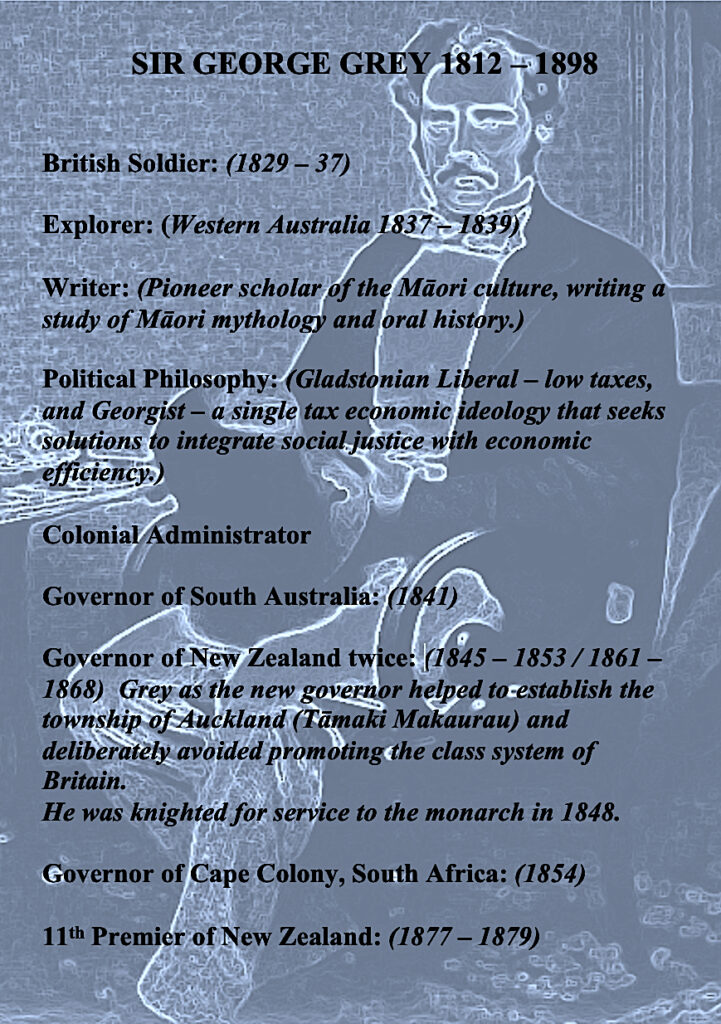
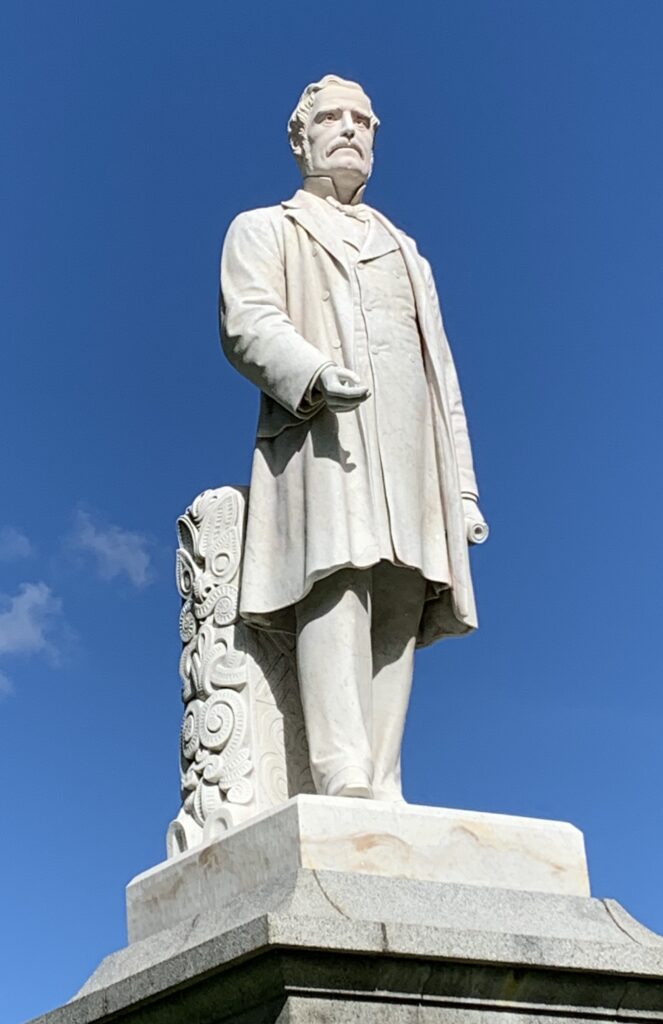
CREATING CHANGE: I am pleased how this above photograph turned out, because the silhouetted creamy-white stone figure is striking against the brilliant blue background. The light falling upon the statue is crisp and clear, and its form is bold. The only digital change I made was to crop a side edge, and centralise the figure. Yet, to keep my connected monotone effect of a black, white, pale greyish-blue colour scheme for my ‘Final Wall Display’, I needed to change this above photograph to a grey white contrast (see below).
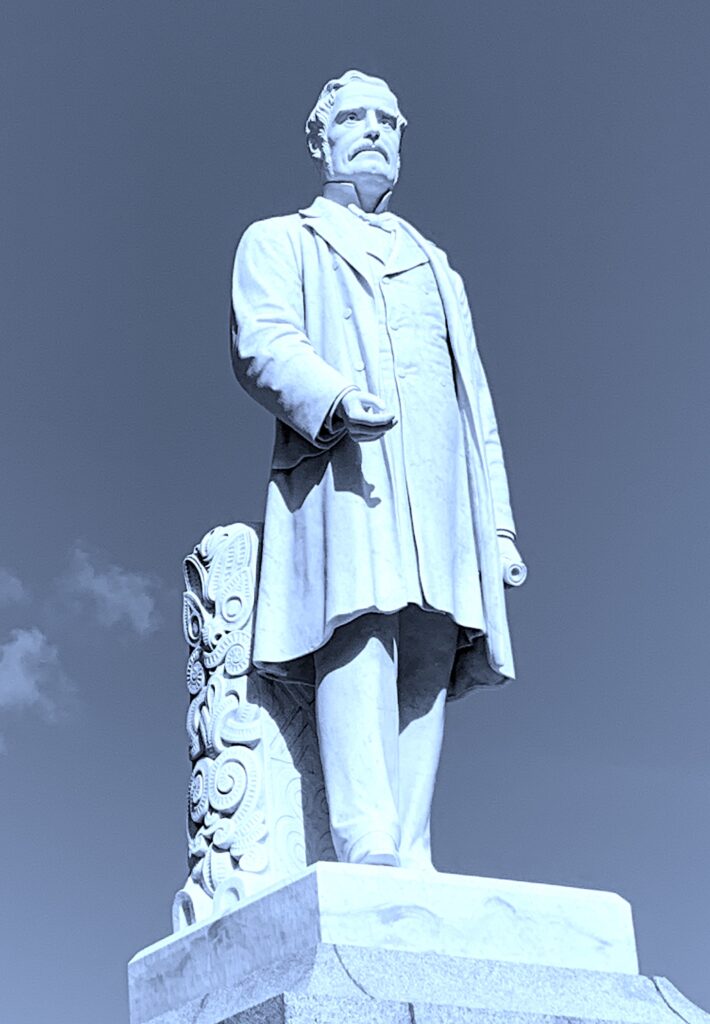
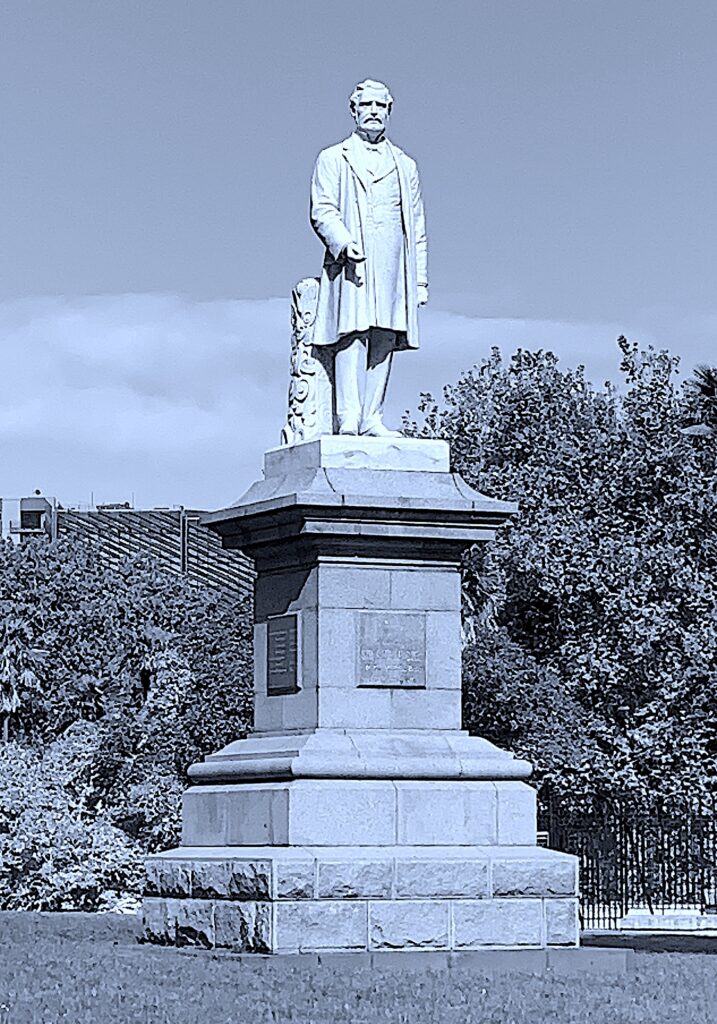
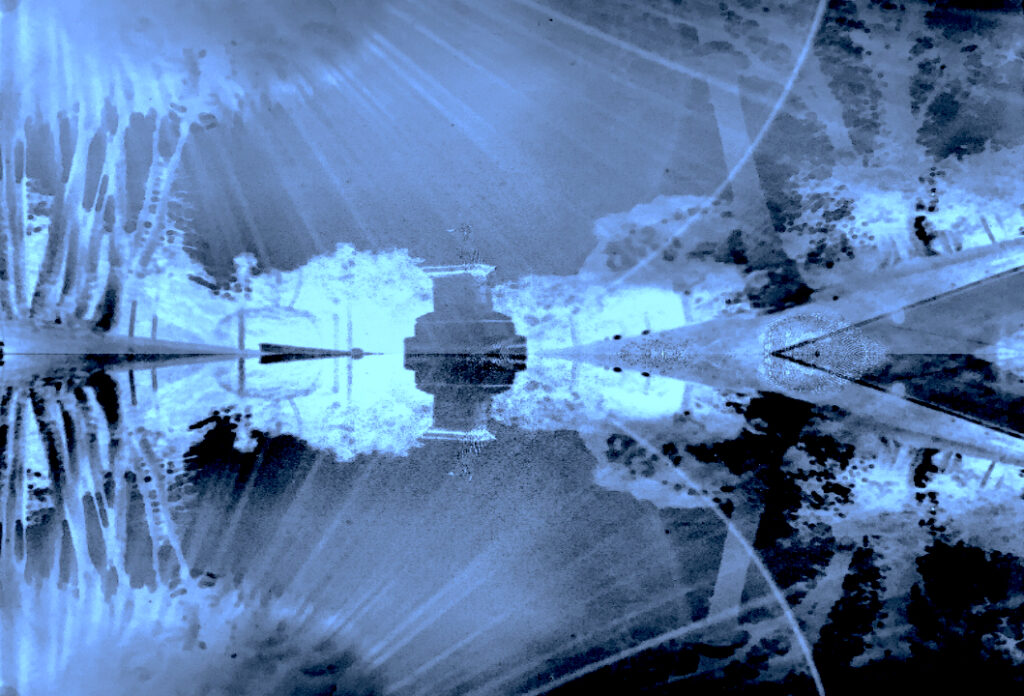
CREATING CHANGE: As the above Pinhole negative photograph did not turn out as clearly as I wished, I wondered if I could digitally enhance it. First, I manipulated the original negative by holding it up to the light of a window, and rephotographing it using my digital camera. I enhanced it using colours and tones. Then I created a double exposure, by photographing it again as an upside down image, and adding it to the original negative to make a reflection image. Next, I played around enhancing the original darkly-exposed negative. Once again, I was recovering my past (thus me), as my reflective image above reminds me of a theatrical (white-blue lit) stage backdrop set from the moonlit forest scene of the Ballet Giselle.
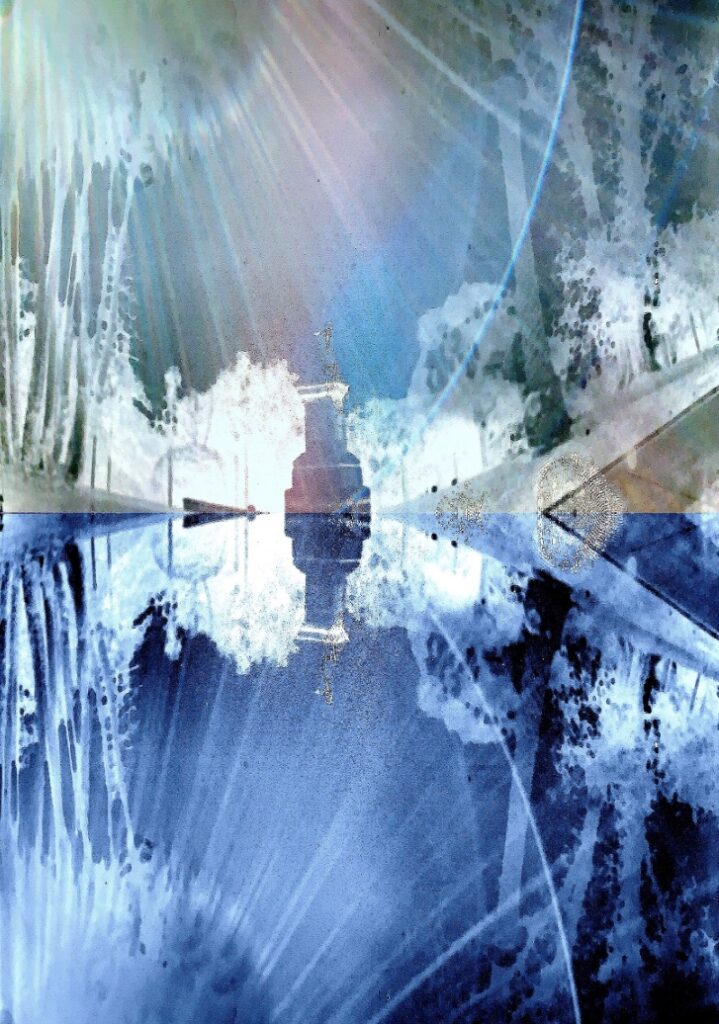
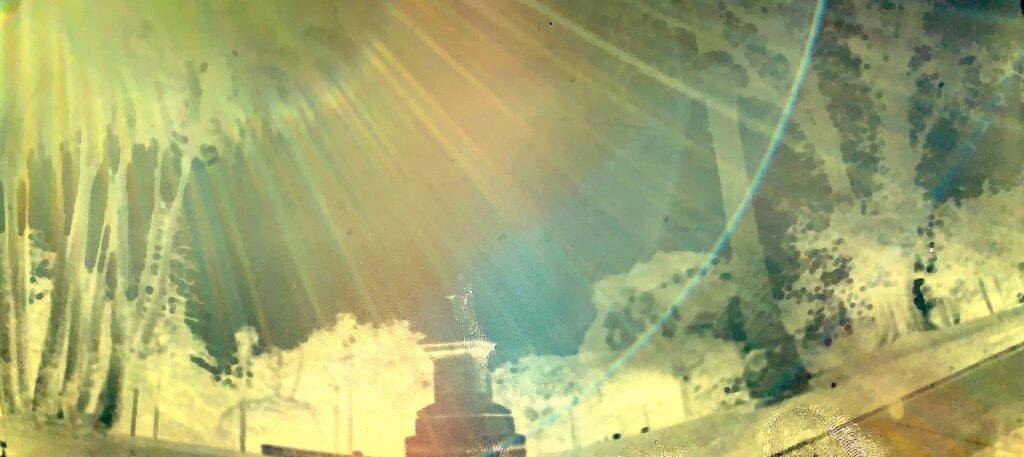
CHANGE: Here is the original Pinhole image size above. I created a CHANGE by manipulating the light exposure to produce a range of colour tones such as gold and pink to enhance the image.
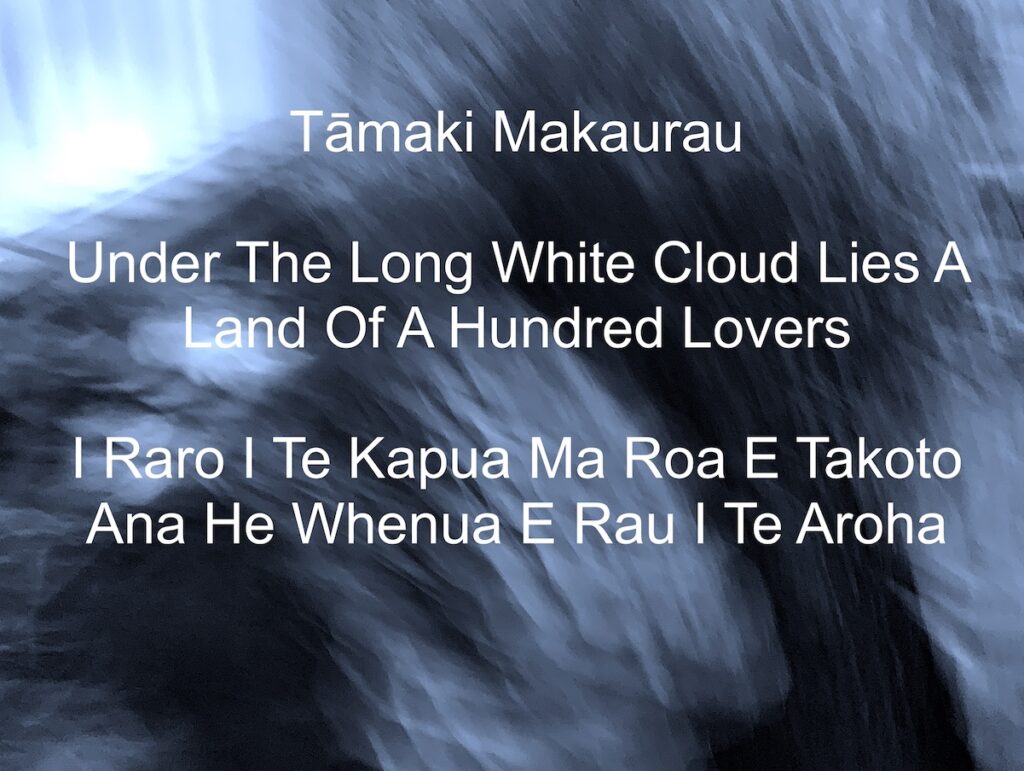
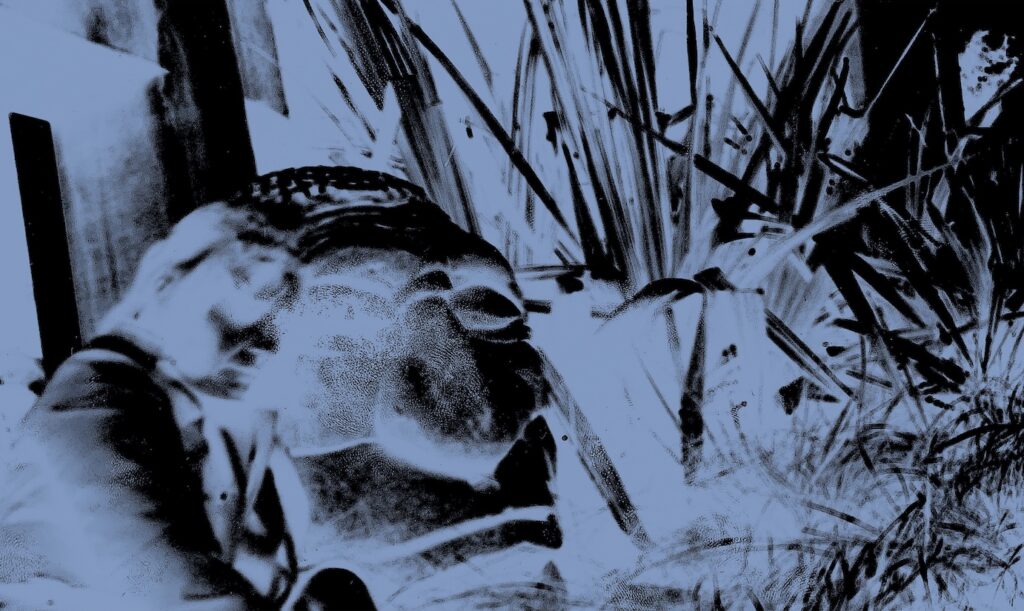
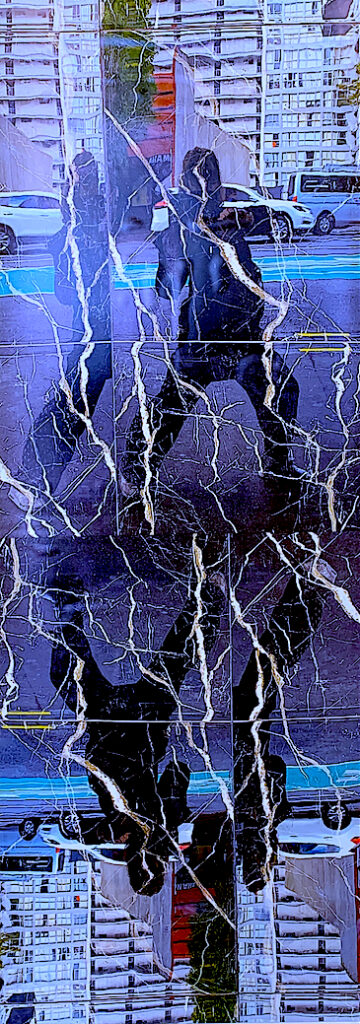
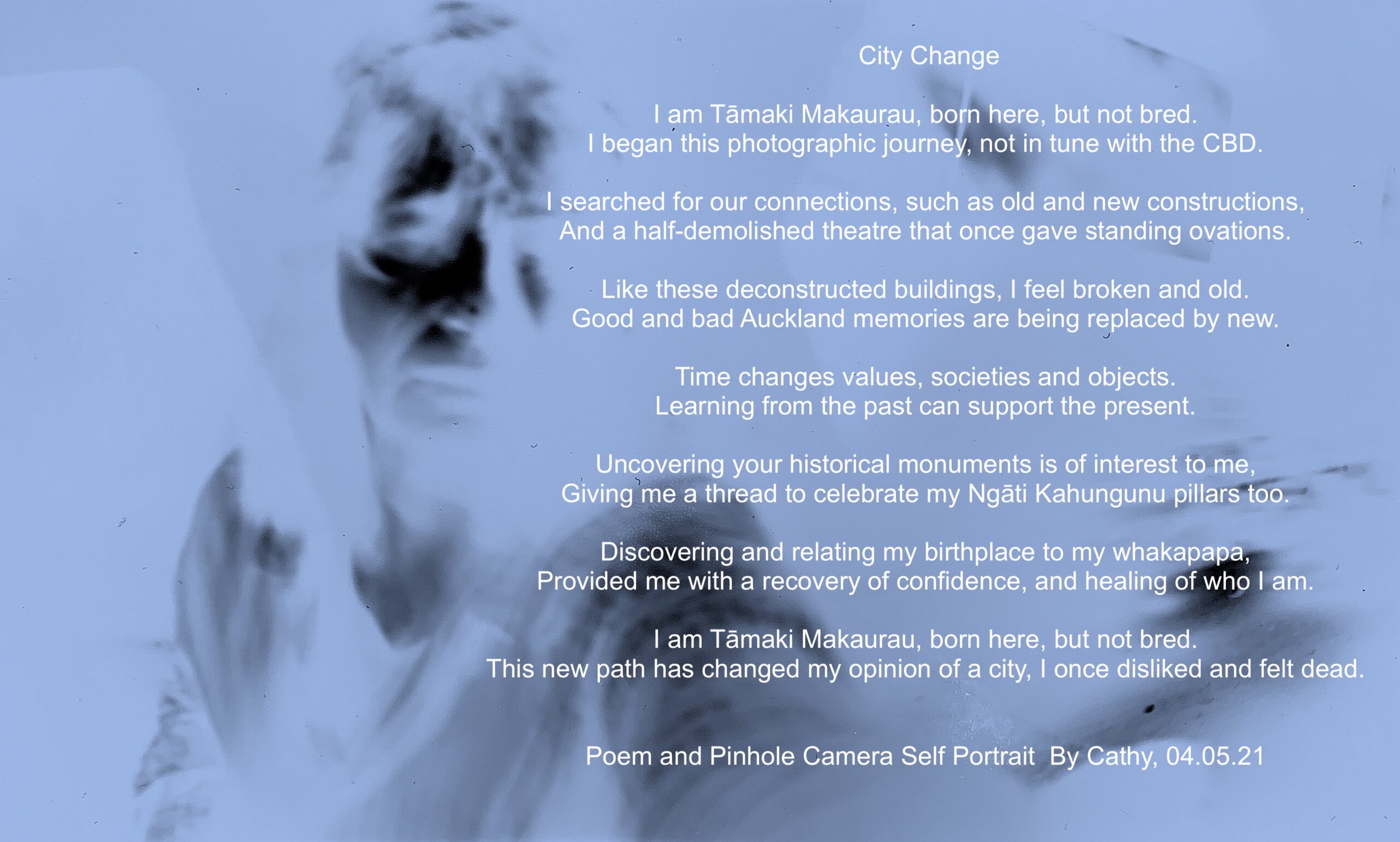
In reflection, I have found every part of this photography brief, from the exploring, discovering and uncovering the city’s CBD to my own suburb, very exciting. Daily, the dog takes me for a walk, therefore I have many familiar walking places in my own home patch, and I am always noticing new things that get discussed as a family. Yet, to engage in a leisurely stroll around the CBD has not happened for me since the early 1990s. Of course, I visit certain places (like the theatre or art galleries), yet not many suburban-types walk the CBD city streets if they do not work there.
This was a great learning curve for me, and my confidence, because I have not had any photographic experience apart from the occasional use of my mobile phone camera. AND… I must be the only one in the world who is not interested in clicking selfies, or sharing one’s life on Facebook, etc., etc.
This brief has made me feel incredibly fortunate to be at art school, and to have the opportunity to freely roam and direct a photographic click towards a place, or space, at my own pace. I enthusiastically engaged in the brief’s focus by shooting a huge number of photographs showing life and object details, and displaying a range of colours, textures and patterns in both my suburb and city. I was passionate about discovering and uncovering objects that were a true representation of me, such as nature (plants, rocks, fungi), sculpture (old or new), and human-made architecture (old and new). I explored new photographic ideas at a suburban beach and a local neighbourhood graveyard, and I researched information about these places. It felt satisfying to achieve instant image results with the digital camera, and to achieve some successes with the pinhole camera.
During this brief of ‘Discover, Uncover and Recover’, I have had many new art ideas and subject matter that is of interest to me. These showed linkages that connected Auckland CBD with my suburb. Governor Grey once owned an 1870s house, a few houses away from me in my suburb, thus I started to unravel and recover his story, and his monument in the city. Auckland’s CBD underground springs are a subject matter that connects to my suburb’s underground volcanic caves and a large natural spring. Plus, I realised the connection between the colonial Victorian named street signs from my suburb had been repeated in the CBD. It was another colonial imposition to name streets after places from another country, where there were already Māori place names here. Queen St, Symonds St, and Victoria St were named in my suburb, because it was one of the first settler suburbs in Auckland, and it became a Borough Council. As, I already owned a book revealing the history of my suburb, I re-read it to rediscover. It showed old photographs of my suburb’s original shoreline: a beach. This environment has gone through immense CHANGE, because land was reclaimed from the foreshore, and a motorway and tidal lagoon replaced the beach, just like the CBD’s reclaimed shoreline. Therefore, here was another discovery and connection I had made about my suburb and the CBD city.
A major strength of mine when working, is the ability to focus and concentrate for long periods of time. I clearly see minute details such as shadows upon objects, and have an ability to shut out the noise around me, to consistently focus, and to be in the present. I put my heart and soul into everything I do, therefore I believe my work engaged in the brief totally, and I was constantly focused to learn as much as I could in the studio.
I am incredibly visual and spatial. I have a good eye for noticing and really looking, with a natural ability to see a connection between a line, angle, direction, movement, colour, shape, form, proportion and design. I have a strong sense of spatial awareness (gained as a dancer), and understand my place, my body in space, and the surrounding space. Therefore, I was always trying to improve my digital and pinhole camera photography. The only changes I made to my digital work was to shift the colour tone and crop to balance the proportion of the image. Even when my pinhole negatives looked under or over exposed, I kept pursuing the goal to improve the next one, in order to get an even balance of light and dark objects within the negative space.
I am interested in history. Therefore, I spent time researching, and carefully considering how to connect and present the historical monuments at Auckland’s Albert Park into my other themes. When I first photographed the monument of Governor Grey, I assumed the worst, that the pou at his feet was like a servant. Yet, after researching, I gained a more educated opinion about the man. I also gained more knowledge about William Hobson, and felt a personal whanau connection, because my Great, Great, Great Grandfather was a Treaty of Waitangi Signatory, not in Waitangi, but on the Kapiti Coast. I questioned why Hobson did not have a statue, if he is considered the father figure of Auckland city? I also questioned, where in Auckland city are the sculptural artworks celebrating Māori leaders?
I utilised size, by up-scaling each photographic work to an A3 size to create a more effective and powerful final display presentation. I purchased the best photographic paper that I could afford. I scaled my centrally placed self-portrait up to an A2 size, which then was doubled, because I added another A2 upside-down reflection under this.
I interpreted the brief project as best as I could in the time allowed. I found many ideas to be exciting, therefore I was able to generate original ideas easily, such as discovering and uncovering a theme of fungi, as I discovered them on my first day’s walk in the city. This motivated me to turn my lens low towards the ground, and it amazed me that I started to see a variety of mushrooms daily for the next four days!!! Selecting one overall concept was quite difficult to do, as I seem to have a river of ideas, but I chose the big concept of CHANGE as an overarching theme, and to support my learning in the brief.
As I find the big picture important, another strength I have is an ability to visualise my end product goal, with the accumulation of my ideas resolved. My first idea was to create three vertical hangings from the ceiling, slightly layered behind each other. My photographs were to be joined together in one flow, with no gaps on grey wallpaper.
My second idea was to create a sculptural construction made from a polystyrene panel (perhaps, building a photographic sculpture at home could be a development that I pursue). This was to represent a high rise building or monument, (part of my Change City theme). I could have easily and efficiently pinned my photographs onto cut out tall, thin, triangular pieces that stood upright, back to back with tape. This sculptural construction would have linked my three thematic concepts (Change of People via Monuments and Whakapapa / Change of Construction via Old and New buildings / Change of Me – exploration of the city, and the pinhole camera), and been more interesting than my final display.
These original ideas above, would have been easier to create, because neither would have involved measuring the space with a ruler around, and in between every photograph to represent a film strip. It was difficult to make a film roll strip as my final display. I cut out some paper squares to add to the side like a film roll, but it just looked wrong, and quite tacky, and cutting inner squares would have taken far too long. To overcome this difficulty, I had to leave the black paper-card sides empty, as adding anything made it look far too cluttered and busy, plus it would have taken the eye away from the actual focus of the photographs. I even thought I could draw in pencil shaded squares on the black card-paper, but I ran out of time. Therefore the final presentation only gives an impression of a film roll. I was a little disappointed with my final product, as it was not how I had envisaged it.

I completed each requirement of the brief to my best ability, and I tried not to overly rush. Instead, I have an enormous amount of energy and drive, and I just enjoyed clicking away. I achieved a high volume of output without even knowing, but by the end it enabled me to see my progress, and understand what a good photograph actually looks like. I am inspired by simplicity, yet understand this is hard to achieve. Perhaps, ‘Less is more’, needs to be a goal in my future art making. My ideas are often complicated, and full of connections, and my final product has complicated ideas. I wanted to produce a three-part story that connected my best photographs: (the new architectural buildings with the old). Then, I wanted to connect these older Victorian style city building photographs to the Victorian settler people who made them. This then led me down a path to unravel more stories about the Victorian empire, such as the Victorian monuments, etc. Therefore, if I had time, I would really extend this project to incorporate more colonisation impacts, which are still causing society problems today.
I have gained and learnt new skills after using a paint-can Pinhole camera. It was exciting working in a darkroom, mixing the photographic paper with chemicals to create a negative. I would like to continue to improve on the exposure timing, and further explore to understand the light conditions.
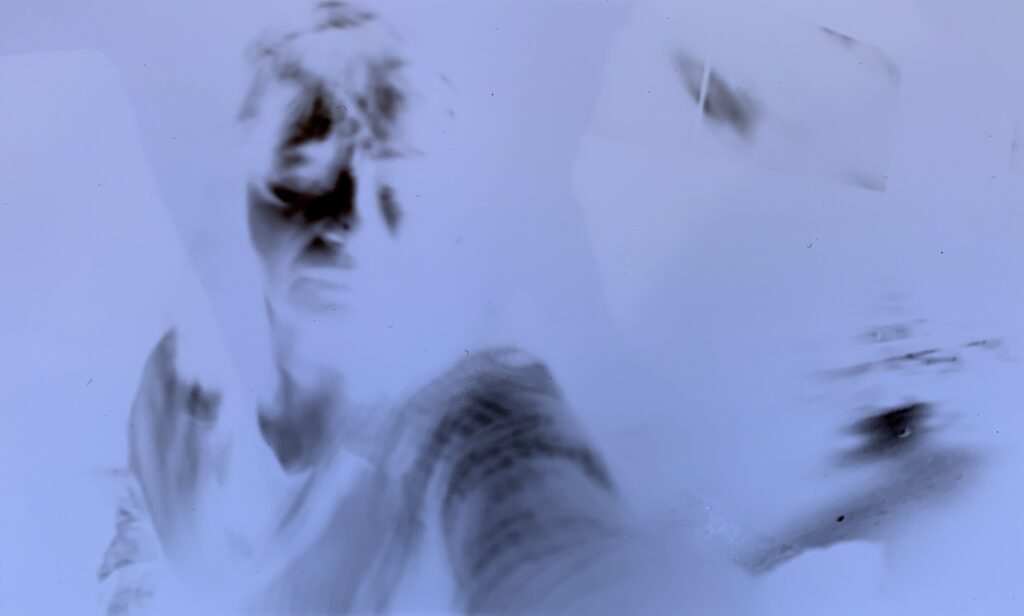
I also spent time improving my 2D and 3D media processing skill-set by working with the photographic and printing technicians to scan a pinhole negative for inversion, plus used the photocopy machine to invert, and using the printing machine to enlarge a digital photograph a number of times (see below).
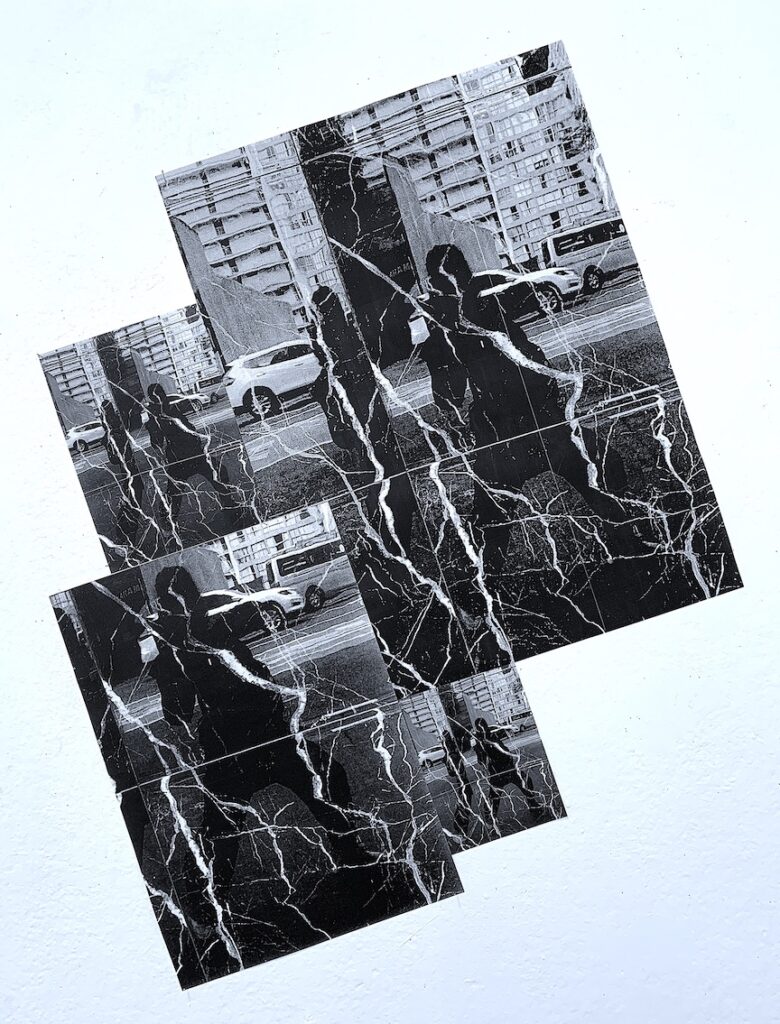
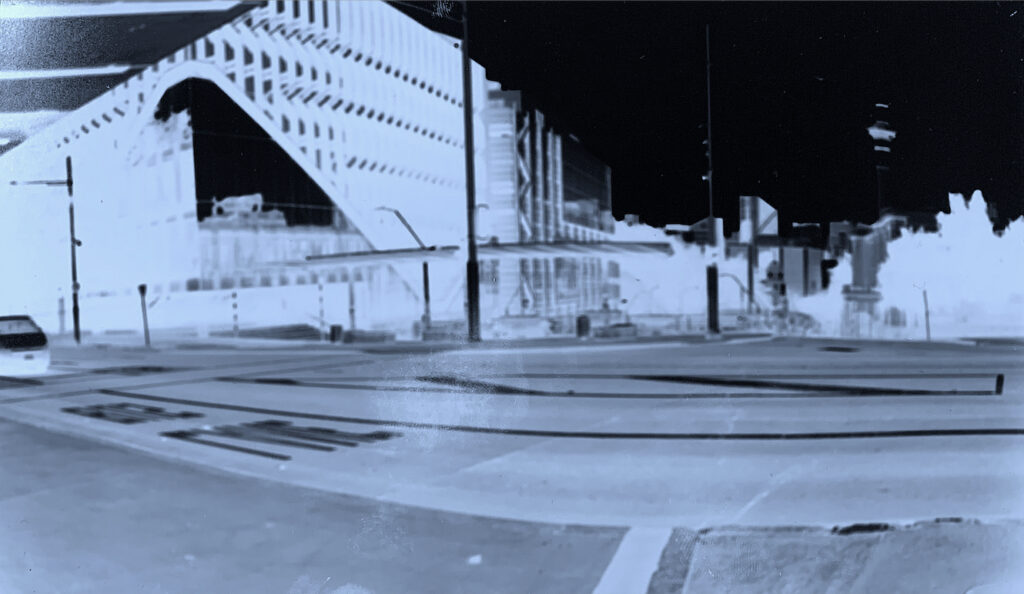
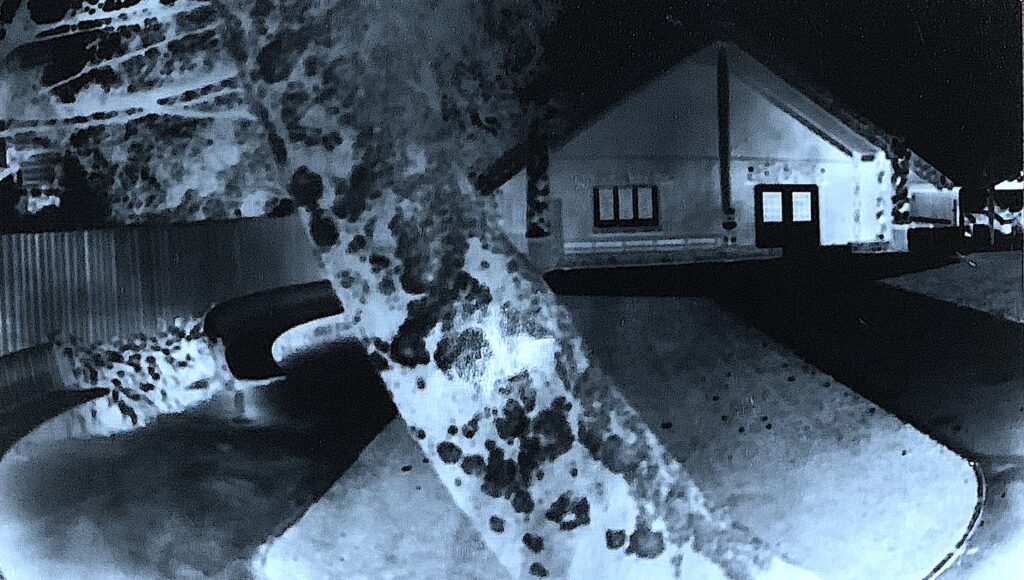
I am proud of my progress in photography over the last four weeks. I have been open to learning at every lesson, and have listened hard to discover new ideas to explore. I am interested in uncovering more of the history of the camera, and the use of modern cameras. My next step is to further extend my knowledge of contemporary and past photographers, and their work.
Overall, I have gained enormously in the RECOVERING part of the brief, identifying objects that represent me, and gaining a much thorough understanding of the city where I was born. I feel like I have recovered a happier part of myself too, yet I still need to gain confidence and believe in myself as an artist and as a person.

Great to see your enthusiastic engagement with the brief. It is wonderful to see you take risks and be explorative in your making.
It is great to see you explore the potential in the media and process to develop ideas.